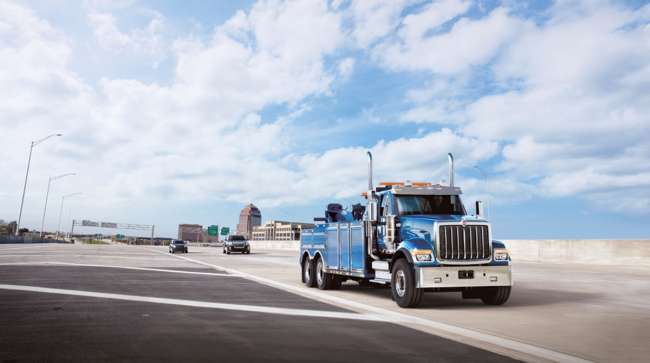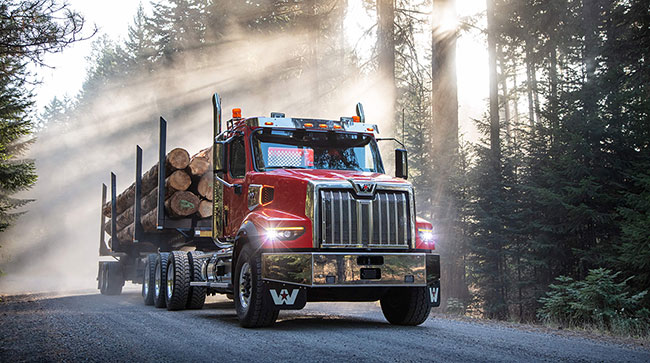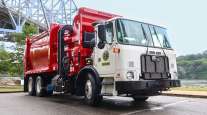Special to Transport Topics
Vocational Segment Increases Adoption of Advanced Safety System Technology

[Stay on top of transportation news: Get TTNews in your inbox.]
As the rate of adoption of driver-assist safety technology continues to rise with over-the-road (OTR) fleets, the vocational truck market — fleets consisting of dump trucks, utility trucks and public transit vehicles — is also experiencing the increase of such industry applications.
The trend illustrates a sharpening focus on safety technology as vocational truck builders and operators seek to leverage systems developed initially for over-the-road and migrate them, with adaptation and some re-engineering, into vocational applications.
The benefits: improved driver safety performance and reduced driver fatigue, increased avoidance or prevention of crashes or other safety incidents, risk mitigation leading to lower claims and insurance premiums, and increased equipment uptime.

Koester
“One of the most important measures of a vehicle in the work truck space is its drive and duty cycle,” explained Kevin Koester, senior director at NTEA – The Association for the Work Truck Industry. “These vehicles typically operate in a smaller, defined geographic area, during daylight hours and at slower speeds, and many spend a high percentage of operational hours parked at a work or delivery site.”
Safety technology is in the early adoption stage for vocational vehicles. The catalyst to increased adoption, Koester believes, will be continued advances in the technologies “making it easier to incorporate the systems into vocational trucks.”
He noted that companies are recognizing the value, particularly in the case of collision mitigation systems that help reduce incidents and “keep more of the fleet mission-capable.”
“The market defines what is successful,” Koester said. “Features like automatic emergency braking, blind spot monitoring, increased use of camera systems and simple reverse sensors all are working to reduce incidents and keep the driver and the vehicle [safe and] on the road [or the job site].”
Safety systems that have demonstrated results in the OTR market are increasingly proving themselves in the vocational space, and that is driving more adoption, notes Len Copeland, product marketing manager for Detroit at Daimler Trucks North America.
“Safety features and active safety systems are one of the fastest growing options with customers [and] demand for advanced safety systems is rising among vocational truck users,” he said.

Western Star 49X Logger. (Daimler Trucks North America)
Copeland stated that job site safety is a big priority to vocational customers, driving demand for Daimler’s Side Guard Assist and Detroit Assurance products. He said that the new Western Star 49X is the first vocational chassis to feature the industry leading Detroit Assurance suite of safety and driver assistance systems as standard equipment.
“Uptime is everything in the vocational market. With vocational equipment being so specialized, there is not typically a backup vehicle sitting in a compound waiting to go to work,” Copeland says. “Even minor accidents — such as a low-speed, rear-end collision with another vehicle on the way to a job site — can be expensive in terms of lost hours. Entire projects are at risk of coming to a standstill with out-of-commission specialized trucks.”
Adoption Challenges

Copeland
Demonstrating return on investment (ROI) for these active safety systems is different from that for passive systems, like seat belts or air bags, Copeland notes. Advanced safety systems “are busy at work all day predicting and preventing collisions,” and for that reason data on system performance is the foundation for understanding and evaluating ROI.
“In addition to increasing uptime and drastically reducing collision costs for vocational customers, there is a big story to tell around insurance premiums. Our customers tell us that skyrocketing insurance prices are being contained with the use of safety systems,” he said.
Tim Wrinkle, Mack Trucks construction product manager, echoes the point about insurance, citing the cost of accidents.
“In general, after factoring in all the costs associated with an accident, preventing even a single accident far exceeds the investment in the active safety features for collision avoidance,” he says. Add in the potential cost of property damage or a fatality and the ROI from avoiding or mitigating such instances is amplified.
He argues that while vocational trucks spend much of their time on job sites, safety technologies still play an important role. Electronic stability control, such as that with the Road Stability Advantage suite for the Mack Granite model, is particularly important for vocational vehicles with a high center of gravity or dynamic loads, such as concrete mixer trucks. “We continue to see an increase each year in the number of vocational customers spec’ing Mack RSA,” although the uptake is lower than on Mack’s highway tractors, he noted.

Stasell
Mark Stasell, vice president of the vocational truck business for Navistar Inc., says the biggest difference in the vocational truck market is “you not only have to keep the driver safe but also the people on the job site. You might have people, pouring concrete, laying forms, troweling cement so you have to worry about them [interacting with the truck] in addition to the driver.” And with some vocational trucks fitted with upwards of a half-million-dollar body on the back, Stasell says part of the safety strategy is protecting the equipment as well.
Another challenge is the unique configuration of vocational trucks. Unlike the mostly standard design of a Class 8 truck, vocational trucks have all types of specialized equipment and operating needs that create additional challenges to incorporating safety systems.
A lot of focus is placed on driver awareness systems that alert the driver and keep them from making mistakes that might damage equipment, Stasell says. “Equipment protection is big,” Stasell explained. “Alerts to protect and remind [the drivers] make their lives a little easier, help destress them, and work with them [to prevent mistakes] when they are tired.”
Dan Williams, director of ADAS and Autonomy for the commercial vehicle division of ZF Group, says that OTR trucks have basically two “duty cycles”: high-speed lane keeping and low-speed maneuverability. Vocational trucks, by contrast, deal with those as well as other duty cycles unique to their work sites or jobs, they are much different from one application to another, and have different equipment configurations that affect how safety systems are designed and installed.
“There are so many different niches of duty cycles that help determine which of these technologies can walk across [to vocational],” he said. “A lot of times the configuration is varied, like wheelbase, height, windshield angle, which is important for cameras. So when you look at a lot of these [applications], it’s based on sensors and systems [that need to be] developed for specific sensor locations.”
To the extent all these things can change, the overall sensor layout has to be re-examined. “That’s the biggest thing that keeps a lot of this technology from walking over to the vocational segment,” he notes.
Pedestrian Safety
Newer safety applications are also benefiting other areas of the vocational market, especially in the school bus segment.
“Talk about an app for a vehicle that is surrounded by pedestrians and other vulnerable road users,” Williams said. “As we continue to develop technology that detects vulnerable road (or job site) users, we are likely to see more application in these user groups,” he notes, adding, “you don’t see a lot of pedestrians wandering around a limited access divided highway.”
Rearward and side blind-spot detection also garners significant interest in the construction and waste hauling businesses. Williams recalls a conversation with the manager of a garbage truck fleet, who told him that “bad things happen whenever a vehicle is put into reverse,” and based on experience, the manager could predict the cost of an incident when a truck backed up. So rear blind-spot technology, whether active or passive, “is an example of a technology [in vocational use] that would pay for itself pretty quickly [by eliminating or reducing backup crashes],” Williams said.
Another vocational segment with upside, Williams says, is urban transit buses, which spend the day in stop-and-go traffic, continually turning and navigating congested city streets.
“Literally those drivers are driving around city blocks all day, working the steering wheel constantly, mostly at low speeds,” Williams says. “With our ReAX electronically controlled steering, we have shown we can reduce driver effort by something like two-thirds, which also has a huge impact on [reducing] driver fatigue. Transit people are pretty excited about that,” he noted, adding that in one instance where one district’s transit drivers were given a choice between a bus with traditional hydraulic steering and one with electronic-assist, they overwhelmingly chose the one with electronically assisted steering.

Thomas
“What it comes down to is helping the driver come home safe every trip,” said TJ Thomas, director of marketing and customer solutions-controls group for Bendix Commercial Vehicle Systems. Its Wingman Fusion product has gained strong adoption in the over-the-road market, and while uptake rates in the vocational market “are behind that,” he says Bendix sees the opportunity and is “in the middle of a study to better understand why.”
He cites the millions of miles of road experience with collision mitigation, blind spot detection and other well-deployed driver-assist safety technologies in the OTR world as a strong baseline to work from. He believes that solutions for vocational trucks will be built on “a very similar process for discovery and development of the technology, it’s pretty much the same at a core level,” as well as “the same kind of evolving, extensive validation on our side and with the OEs.”
The opportunities to improve safety applications in the vocational truck market will reduce crashes and related injuries, reduce driver fatigue and increase uptime, thus accelerating the adoption of advanced safety systems in vocational trucks, believes Christopher Lyon, NTEA’s director of fleet relations.
“People make mistakes, plain and simple,” he says. “While these technologies cannot overcome simple physics, they can ... help a driver maneuver a large vehicle in a tight space with a decreased chance of incident, which can have a significant impact over time.”
Want more news? Listen to today's daily briefing below or go here for more info:


